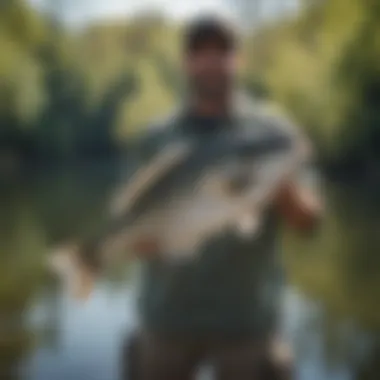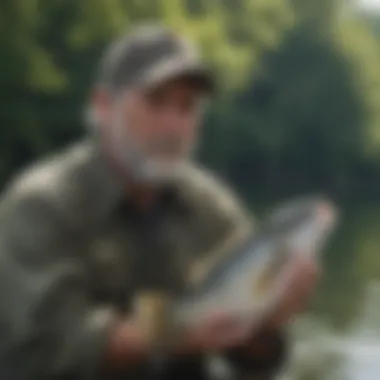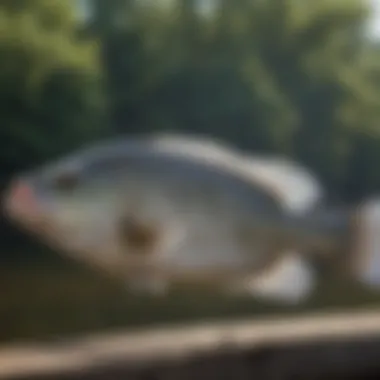Experience the Thrill of Crappie Fishing in Tennessee's Waterways


Animal Species Profile
- Physical characteristics and appearance When angling for crappie in Tennessee, anglers can expect to encounter fish ranging from 5 to 12 inches in length, with the potential to grow even larger in nutrient-rich waters. Black crappies typically possess a darker overall hue with irregular blotches, while white crappies display a lighter body coloration with vertical bands along their sides. Both species feature large, protruding eyes and dorsal fins harboring spines.
- Natural habitat and distribution Crappies thrive in the diverse aquatic ecosystems of Tennessee, populating bodies of water across the state, from sprawling reservoirs like Kentucky Lake to smaller ponds and rivers. They exhibit a preference for structural cover such as aquatic vegetation, fallen trees, and rocky outcrops, which provide shelter and foraging opportunities. This adaptability contributes to their widespread distribution throughout the region, making them a popular target for recreational anglers.
- Behavior and social interactions The social behavior of crappies is characterized by their tendency to form tight-knit schools, especially during spawning season in early spring. These fish communicate using subtle movements and gestures, coordinating their movements to navigate through the water column in search of prey. While primarily piscivorous, crappies also consume insects and small crustaceans, exhibiting opportunistic feeding behavior in response to environmental cues.
Introduction
What are Crappie?
Crappie are a species of freshwater fish known for their distinctive appearance and popularity among anglers. Their compact size, silver and green hues, and unique markings make them intriguing targets for fishing enthusiasts. Inhabiting shallow waters, crappie exhibit agile swimming behavior, often moving in schools, presenting both a challenge and an opportunity for fishing enthusiasts looking to test their skills in capturing these elusive fish.
Why Tennessee for Crappie Fishing?
Tennessee stands out as a prime location for crappie fishing due to its abundance of water bodies teeming with these prized fish. The state's diverse lakes and rivers offer a conducive environment for crappie to thrive, ensuring ample opportunities for anglers to engage in productive fishing sessions. Additionally, Tennessee's conservation efforts and fishing regulations contribute to sustainable crappie populations, making it a responsible and fulfilling destination for individuals passionate about the sport of fishing.
Crappie Behavior
Crappie behavior plays a pivotal role in the art of fishing these freshwater gems in Tennessee. Understanding how crappie behave can significantly enhance an angler's success rate. Crappie, known for their schooling behavior, tend to move in groups, making it essential to locate their patterns for a successful fishing expedition. By comprehending their behavioral tendencies, anglers can strategize their approach and improve their chances of a catch.


Feeding Habits
Time of Day for Feeding
The time of day for feeding is a crucial aspect of crappie behavior that influences the success of fishing trips. Crappie exhibit varying feeding patterns throughout the day, with dawn and dusk often being prime times for feeding activities. Early mornings and late afternoons are when crappie are most active, making these periods optimal for angling. Understanding the significance of timing in relation to crappie feeding habits allows anglers to plan their fishing excursions effectively.
Preferred Prey
Crappie have a diverse palate, consuming a range of aquatic creatures that serve as their preferred prey. From insects to small fish, crappie are opportunistic feeders, adapting their diet based on availability. Their predilection for specific prey species depends on various factors, including water temperature and habitat. Anglers must consider the type of prey present in the fishing location to choose suitable baits and lures that mimic these natural food sources. Successfully matching the crappie's preferred prey can significantly increase the chances of a successful catch.
Spawning Patterns
When delving into crappie behavior, understanding their spawning patterns provides valuable insights for anglers. Crappie typically spawn during the spring months, with water temperature playing a critical role in this reproductive process. As temperatures rise, crappie move to shallow waters to spawn, creating opportunities for anglers to target these concentrated areas. By recognizing the seasonal patterns of crappie spawning, fishermen can strategize their fishing methods to target spawning grounds effectively.
Conclusion
Mastering the nuances of crappie behavior is essential for anglers seeking success in Tennessee's freshwater fishing scene. By honing in on feeding habits, preferred prey choices, and spawning behaviors, fishermen can optimize their strategies for reeling in these prized catches. Through a strategic understanding of crappie behavior, anglers can elevate their fishing experiences and enjoy fruitful outings on Tennessee's lakes and rivers.
Best Spots in Tennessee


Top Lakes for Crappie Fishing
Reelfoot Lake
Kentucky Lake
River Hotspots
Tennessee River
The Tennessee River offers a distinct allure for anglers seeking crappie hotspots in Tennessee. The key characteristic of the Tennessee River is its strong current and the presence of underwater structures that attract crappie throughout the year. Anglers favor the Tennessee River for its consistent fish populations and the chance to catch crappie of varying sizes. However, anglers must navigate the river's currents and changing water levels, presenting a challenge for those looking to maximize their fishing success. Despite these factors, the Tennessee River stands out as a beneficial choice for anglers aiming for a dynamic and rewarding fishing adventure in Tennessee.
Tackle and Equipment
Rod and Reel Selection
Within the realm of tackle and equipment for crappie fishing, the selection of an appropriate rod and reel combo is a critical decision that can impact the success of your fishing ventures. When evaluating rods, factors such as length, action, and material composition should be taken into account. A longer rod can provide better casting distance, while the action of the rod determines its flexibility and sensitivity to bites. Graphite rods are commonly favored for their lightweight construction and enhanced sensitivity, ideal for detecting subtle movements indicative of crappie strikes. Matched with a quality reel, the rod-and-reel selection process is fundamental in achieving optimal performance during crappie fishing excursions in Tennessee. By carefully considering the specifications of various rod-and-reel combinations and aligning them with the fishing conditions in Tennessee's waters, anglers can equip themselves effectively for a successful outing targeting crappie.


Baits and Lures
When it comes to enticing crappie in Tennessee, the selection of baits and lures holds significant importance in attracting these freshwater fish to your hook. Two primary options that have shown consistent success in crappie fishing are jigs and minnows. Jigs, with their enticing jigging motion, mimic natural prey and are effective in provoking strikes from crappie. Their versatility in terms of colors, sizes, and shapes allows anglers to experiment and adapt to changing conditions on the water, increasing the likelihood of a successful catch. On the other hand, minnows act as live bait that can elicit aggressive responses from crappie, especially during their active feeding periods. The lifelike motion and scent of live minnows make them a valuable addition to any angler's arsenal when targeting crappie in Tennessee's vibrant waters. By exploring the nuances of jigs and minnows, anglers can diversify their approach and tailor their bait selection to maximize their chances of hooking these coveted freshwater species.
Regulations and Guidelines
Size and Creel Limits
Fishing License Requirements
Acquiring the necessary fishing licenses is a fundamental aspect of responsible angling in Tennessee. Before embarking on a crappie fishing expedition, anglers must obtain the appropriate licenses designated for freshwater fishing, ensuring compliance with state regulations. These licenses not only legalize fishing activities but also contribute to funding conservation efforts, habitat preservation, and fishery management programs. Understanding and meeting the fishing license requirements demonstrate a commitment to supporting wildlife conservation and upholding ethical fishing practices in Tennessee's vibrant waterways.
Tips for Successful Crappie Fishing
In the realm of Crappie fishing, mastering the nuances can significantly elevate one's success. As a diverse species, Crappie can be both challenging and rewarding to catch, making understanding the optimal strategies crucial. This section delves deep into the core aspects of successful Crappie fishing, offering invaluable insights and tips for anglers seeking to enhance their skills and success rates.
When it comes to Patience and Persistence, these twin virtues stand as fundamental pillars in the realm of Crappie fishing. Patience is not merely a trait but a skill that must be honed over time. Waiting for the opportune moment, understanding the behavior of Crappie, and staying calm during lulls in activity are essential elements that separate successful anglers from the rest. Persistence complements patience by instilling the drive to persist even when faced with challenges. Whether it's trying different baits, adjusting techniques, or exploring new fishing spots, persistence is key to unlocking a bountiful Crappie catch.
Taking a closer look at Weather Considerations, it becomes evident that weather exerts a significant influence on Crappie behavior. Various weather conditions such as temperature, wind speed, and atmospheric pressure can dictate the activity levels of Crappie. Understanding how these factors impact Crappie movements can assist anglers in predicting ideal fishing times. For instance, Crappie tend to be more active during stable weather patterns, making these periods favorable for angling. Conversely, rapid weather changes or extreme conditions may require anglers to adapt their strategies accordingly, such as targeting different depths or adjusting retrieval speeds.
Conclusion
Enhancing Your Fishing Experience
When it comes to enhancing your fishing experience, it's not just about the catch but the journey itself. Anglers can elevate their time on the waters of Tennessee by immersing themselves in the sights, sounds, and smells of nature. From waking up at the crack of dawn to witness the serene sunrise over the lake to feeling the thrill of a crappie nibbling at your bait, every moment is an opportunity to enhance your connection with the environment. By fine-tuning your fishing techniques, observing crappie behavior closely, and adapting to changing weather conditions, you can elevate your fishing skills to new heights. Remember, it's not always about the size of the catch but the memories you create along the way that truly enhance your fishing experience. Stay patient, stay present, and let the beauty of Tennessee's waters guide you on a rewarding fishing journey.







